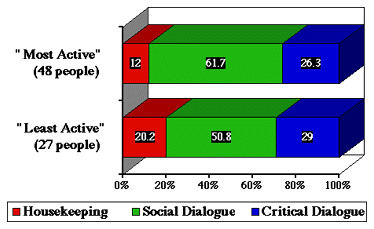
|
|
|
|
||
|
|
Active |
Active |
Active |
Active |
|
|
|
|
|
|
|
DIALOGUE |
|
|
|
|
|
DIALOGUE |
|
|
|
|

I derived a crude measure of shyness from the survey questions 1 (Overall how would you rate your participation in the Rinconada community this year (e.g., taking part in organized or informal activities, socializing with dormmates, etc.)?) and 2 (Overall for activities that you participated in with dormmates this year, how often did you initiate activities?). I averaged the responses to these two questions and then divided Rinconada residents into two categories, "most active" and "least active."
These results might be taken as evidence that shy students may use computer-mediated communication (CMC) to avoid direct face-to-face (f2f) social contact. This could be explored further by studying how shy and less-shy students use private e-mail as well as e-mail lists (while I asked about private e-mail correspondence in the survey, I didn't study the responses in any systematic way). I know of no evidence that without CMC, those shy students would indeed go down the hall and interact f2f with their dormmates instead of posting an e-mail message that, for example, they'd lost their keys or left their chemistry textbook in the lounge. My experience tells me that instead of replacing the CMC housekeeping message with a f2f interaction, these students would simply have no interaction at all, and therefore CMC offers them a communication medium they previously didn't have. In any case I think this phenomenon should be studied further.